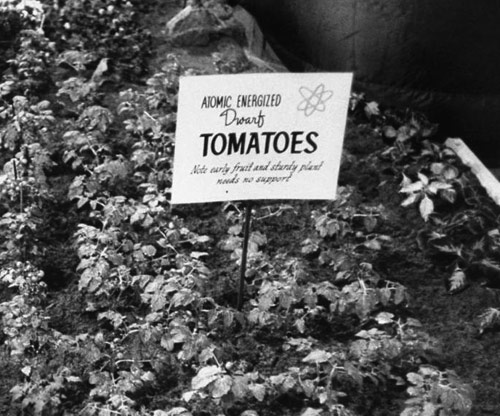Not just a Cold War-era relic…

…the use of radiation to introduce genetic changes in food (aka “atomic gardening”) is alive and well today.
What’s more, the Times adds, nearly 2,000 gamma radiation-induced mutant crop varieties have been registered around the world, including Calrose 76, a dwarf varietal that accounts for about half the rice grown in California, and the popular Star Ruby and Rio Red grapefruits, whose deep colour is a mutation produced through radiation breeding in the 1970s. Similarly, Johnson tells Pruned that “most of the global production of mint oil,” with an annual market value estimated at $930 million, is extracted from the “wilt-resistant ‘Todd’s Mitcham’ cultivar, a product of thermal neutron irradiation.” She adds that “the exact nature of the genetic changes that cause it to be wilt-resistant remain unknown.”
The atomic gardening photos from Life magazine in 1961 are kind of great.
A pair of farmers are growing a huge garden on the top of a former bagel factory in the Greenpoint neighborhood of Brooklyn.
But for some New Yorkers, a vegetable-filled rooftop is far more conceivable and practical than moving to the country. Novak agrees. “When these farmers go in and lecture these inner city kids about dairy farming in upstate New York, it’s in one ear and out the other. But I can tell them, I have two farms in the city,” and they can take the subway and come help on the weekends.
Update: More on urban farming.
How to construct a build-as-you-grow potato bin. Start with a base and some potatoes planted within it and then just keep building up and dumping in dirt. Come harvest time, the box will be full of potatoes.
I’m told a rule of thumb for potato harvests is 10 pounds per pound of seed. I got 25 pounds for my one pound, so I guess I shouldn’t be too disappointed about the results of my first year planting potatoes. Still it’s nowhere near the 60 pound average that Greg Lutovsky’s customer’s experienced. In hindsight I think I got lazy in hilling my potato plants as they were growing. Sometimes I would let them get to be 8 or so inches tall and jungle-like before dumping more dirt in and covering the stems.
- Pruning the list of RSS feeds I follow.
- Digging.
- Writing about hoes.
- Keeping deer out of the
s.
- Growing my traffic.
- Worrying about bees.
- (Com)posting links?
- Weeding out spam from comment threads.
- ^s.
- There’s never enough thyme.
- Wondering about the weather.
4-hour BBC documentary on how to be a gardener. I only watched the first few minutes, but it seems promising. (thx, avi)






Stay Connected